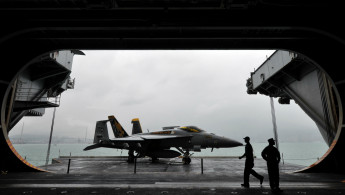US military intervention against Assad 'back on the table'
Since the collapse of a Russian-US brokered ceasefire for Syria in September, Syrian regime advances in Aleppo, backed by Russian air-support on rebel-held east Aleppo have seen hundreds killed and resulted in global outcry, forcing the Obama administration to re-consider its options.
Military intervention on the table
Speaking on Tuesday State Department spokesman Mark Toner said the US was considering "a range of options" that included both working with other countries and alone.
"We always ... consider unilateral options when looking at a situation like Syria," he said. "But ... we're also looking ... at how we can leverage and work with the other members of the ISSG," said Toner, referring to the International Syria Support Group numbering some 20 international states.
On Wednesday, national security officials are set to meet at the White House with the possibility of pursuing military strikes against the Assad regime set to be back on the table.
 |
On Wednesday, national security officials are set to meet at the White House with the possibility of pursuing military strikes against the Assad regime set to be back on the table. |  |
Back-channel meetings inside national security agencies have been ongoing since the US-Russian brokered ceasefire came crashing down following airstrikes on a UN-Arab Red Crescent convoy in Urum al-Kubra, a suburb of Aleppo, on September 19th. Both the Syrian regime and its Russian backers have been implicated in the attack.
Events in Orum al-Kubra occurred shortly after an "accidental" US airstrike in Deir ez-Zor, that the US says intended to target the Islamic State, left over 60 Syrian Army personnel dead, according to Moscow.
Inside US national security agencies, meetings have been going on for weeks to consider new options to address the developing crisis in Aleppo where pro-Syrian regime forces have made advances on the ground into formerly rebel-controlled territory amid intense airstrikes that have targeted medical facilities and water infrastructures in the east of the city.
Whilst military options currently under US consideration remain classified, The Washington Post, citing an anonymous US administrative source, reported on Tuesday that they include bombing Syrian airforce runways using long-range weapons such as cruise missiles fired from coalition planes and ships. The possibility of striking covertly without public acknowledgement, the unnamed source said, represented one particular option to bypass the Obama administration’s long-standing reticence to target the Assad regime without a UN security council resolution.
Russian missiles heading to Latakia
Developments in Washington come on the same day that Russia’s Defence Ministry announced that it had sent an S-300 missile system to its naval facility in the Syrian coastal city of Tartus in order to bolster security, Russian officials said.
A spokesman from the US Department of Defence said on Tuesday that the US administration would "carefully track military developments and installations in Syria, particularly as they affect coalition operations."
But Russian military spokesman Igor Konashenkov has sought to reiterate that the S-300 serves "a purely defensive system and poses no threat to anyone."
"It's not clear why the placement of S-300 in Syria has caused such a stir among our western colleagues," said Konashenkov in a statement.
The Hmeimim air base in Latakia already has an S-400 air defence system, the most modern in Russia's arsenal, which was delivered to Syria in late 2015 to provide additional air-defence to Syrian regime and Russian warplanes, after a Russian aircraft was downed by Turkey on the Turkish-Syrian border on November 28 2015.
Reuters reported on Tuesday that a meeting of the Principals Committee, which includes Cabinet-level officials is scheduled to take place on Wednesday, with the possibility of a meeting of the US National Security Council taking place as early as this weekend.
Previously in September 2013 the Obama administration contemplated military interaction in Syria against the Syrian government after widespread reports it had been responsible for the use of chemical weapons. However, after failing to gain congressional support, the plan was quashed.





 Follow the Middle East's top stories in English at The New Arab on Google News
Follow the Middle East's top stories in English at The New Arab on Google News
![Netanyahu furiously denounced the ICC [Getty]](/sites/default/files/styles/image_330x185/public/2024-11/GettyImages-2169352575.jpg?h=199d8c1f&itok=-vRiruf5)
![Both Hamas and the Palestinian Authority welcomed the ICC arrest warrants [Getty]](/sites/default/files/styles/image_330x185/public/2024-11/GettyImages-2178351173.jpg?h=199d8c1f&itok=TV858iVg)
